 Join CSWEA
Join CSWEA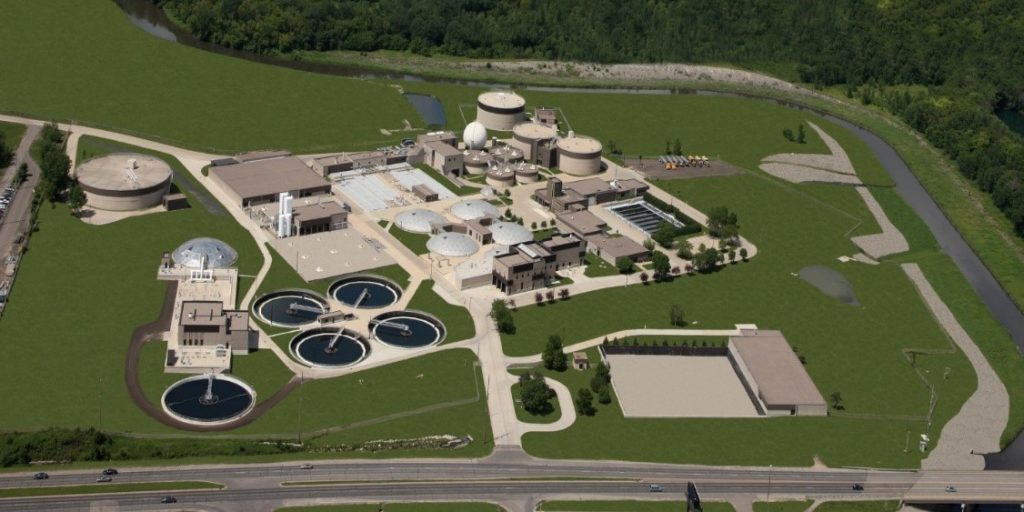
Energy Recovery Projects – Combined Heat and Power
Rochester Water Reclamation Plant
Rochester, Minnesota
The Rochester Water Reclamation Plant has been successfully operating a combined heat and power (CHP)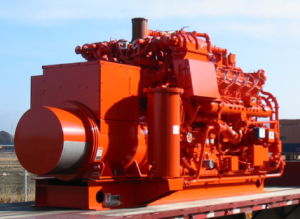 system since 1982. Initially there were 2 generators rated at 400 kW each, however they were upgraded to 1,000 kW in 2002 and 2008. The generators are Waukesha turbo-charged lean burn engines and have the capability to run off methane (byproduct of anaerobic digestion) or natural gas. Heat is recovered from the engine jacket and exhaust gases in the form of hot water (180°F – 190°F) that is used to distribute heat to the anaerobic digesters and seasonal heating of the plant. The engine jacket water system is capable of approximately 2.5 MMBtu/h/engine and the exhaust gas system is designed to recover approximately 2 MMBtu/h/engine.
system since 1982. Initially there were 2 generators rated at 400 kW each, however they were upgraded to 1,000 kW in 2002 and 2008. The generators are Waukesha turbo-charged lean burn engines and have the capability to run off methane (byproduct of anaerobic digestion) or natural gas. Heat is recovered from the engine jacket and exhaust gases in the form of hot water (180°F – 190°F) that is used to distribute heat to the anaerobic digesters and seasonal heating of the plant. The engine jacket water system is capable of approximately 2.5 MMBtu/h/engine and the exhaust gas system is designed to recover approximately 2 MMBtu/h/engine.
Two anaerobic digesters produce approximately 375,000 cu ft/day of biogas that contains approximately 66% methane. This allows WRP typically run the generators between 500-800 kw depending on the season and temperature. The amount of heat recovered is sufficient to provide complete process and facility heating for most of the year (outdoor temperatures as low as 40 degrees). The methane also can also be used in boilers in cold weather and this allows the plant to buy a minimal amount of natural gas, typically only required when temperatures drop below -10°F. The combined heat and power system typically saves around $300,000 annually in heat and electrical costs.
Energy Recovery Projects – Low Temp Loop
Rochester Water Reclamation Plant
Rochester,Minnesota

In 2007 construction was completed on a secondary treatment plant to the Rochester Water Reclamation  Plant that increased the overall plant capacity by 4.8 MGD. A new circular primary clarifier was added with a dome for odor control. While ventilation was accounted for, supply air was taken directly from the ambient atmosphere. During the cold weather months the cold air reacted with the warm moist air from the process liquid creating a microclimate within the dome that resulted in fog, condensation, and even precipitation. This atmosphere created an environment that resulted in rapid deterioration of the metal components in the primary clarifier.
Plant that increased the overall plant capacity by 4.8 MGD. A new circular primary clarifier was added with a dome for odor control. While ventilation was accounted for, supply air was taken directly from the ambient atmosphere. During the cold weather months the cold air reacted with the warm moist air from the process liquid creating a microclimate within the dome that resulted in fog, condensation, and even precipitation. This atmosphere created an environment that resulted in rapid deterioration of the metal components in the primary clarifier.
To resolve this issue a hydronic heating system that uses thermal energy taken from final clarifier effluent is used to heat supply air into the primary clarifier during the cold winter months. This effectively stopped the microclimate reaction and mitigated the deterioration of the metal components. Simply installing a heater or using the existing hot water loop would have resolved the issue as well but would have driven up capital and operating costs. The system operates with a coefficient of performance of approximately 5.2. This means that for every unit of energy that is input to the system, 5.2 units are output. The difference in energy is heat that is recovered from the effluent water. This results in operating cost savings of approximately 20%-50% vs. using natural gas. The capital cost of the system was approximately $500,000.
Metropolitan Council Environmental Services (MCES)
Blue Lake WWTP
Shakopee, Minnesota
MCES has put a strong emphasis on renewable energy and 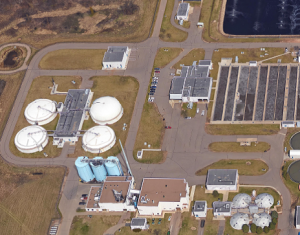 energy recovery. In 2012, MCES built a new solids processing facility at its Blue Lake Wastewater Treatment Plant in Shakopee. With the help of new anaerobic digesters to process solids, the plant produces methane biogas for fuel, replacing most of the need for natural gas to power the facility. The conversion from natural gas to biogas fuels a dryer that processes solids into pellets and saves an estimated $500,000 a year that would otherwise be spent on natural gas. That biogas fuel has enough capacity to heat about 900 households and the dried pellets are sold as fertilizer.
energy recovery. In 2012, MCES built a new solids processing facility at its Blue Lake Wastewater Treatment Plant in Shakopee. With the help of new anaerobic digesters to process solids, the plant produces methane biogas for fuel, replacing most of the need for natural gas to power the facility. The conversion from natural gas to biogas fuels a dryer that processes solids into pellets and saves an estimated $500,000 a year that would otherwise be spent on natural gas. That biogas fuel has enough capacity to heat about 900 households and the dried pellets are sold as fertilizer.
Also at Blue Lake is another ambitious project. MCES last year entered into an agreement with Oak Leaf Energy Partners of Colorado to install and maintain a 1.25 MW solar energy facility on the site. The solar facility provides about 10 percent of the treatment facility’s electricity needs, with plans for expansion currently in the works. Combined with the biogas initiative, Blue Lake is becoming a model of sustainable energy.
Basic facts for the Blue Lake behind the meter solar pv system.
Metropolitan Council Environmental Services (MCES)
Metropolitan WWTP
Saint Paul, Minnesota 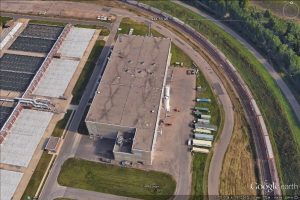
MCES has put a strong emphasis on renewable energy and energy recovery. In 2012, MCES built a new solids processing facility at its Metropolitan Wastewater Treatment Plant in Saint Paul. With the help of new efficient fluid be reactors to process solids, the plant produces waste heat steam replacing most of the need for natural gas to heat the plant facilities. The conversion from heat energy to waste heat steam saves an estimated $1,400,000 a year that would otherwise be spent on natural gas. Through complete combustion of residual solids, 900 tons per day of sludge cake is reduced to 40 tons per day of phosphorous-rich ash that can be utilized as a fertilizer. The Metropolitan Wastewater Treatment Plant has two turbine generators capable of producing up to 4.5 megawatts of electricity. Most of the power produced is generated in the summer when peak electric costs are at the highest rates. The annual energy savings is about $1,100,000 / year.
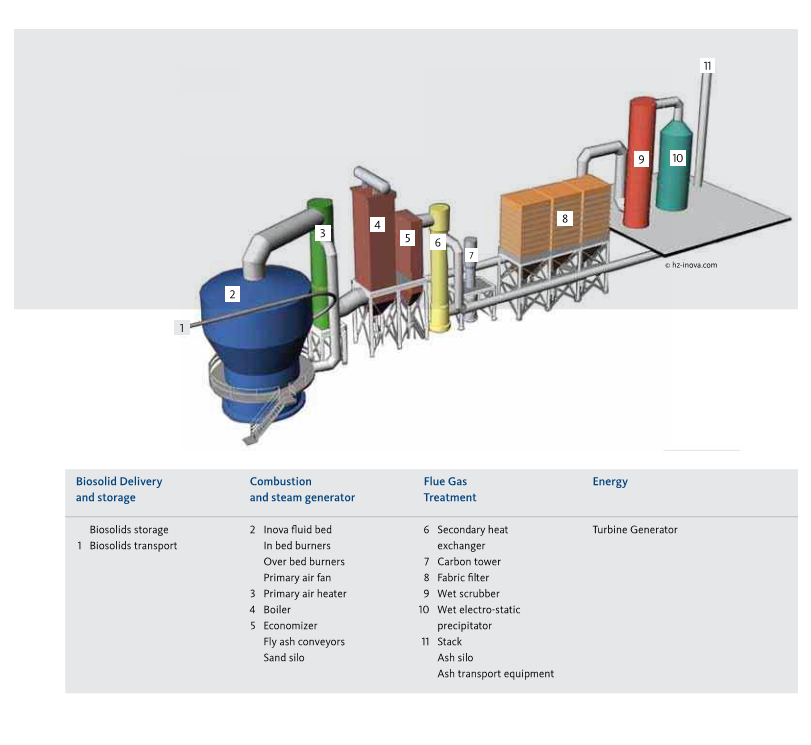
Biofuel Recovery Project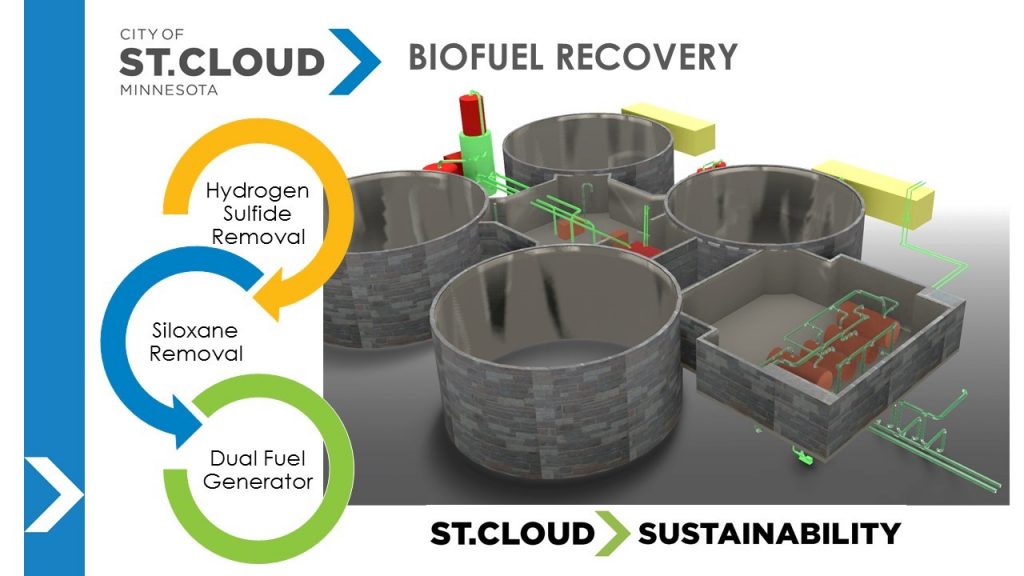
St. Cloud, Minnesota
St. Cloud Resource Recovery Facility, Design Capacity: 17.9-MGD
The project components include; installation of gas conditioning – siloxane and hydrogen sulfide removal and installation of a 633-kW Jenbacher dual fuel internal combustion engine generator.
At one-hundred percent efficiency, the engine generator has the potential to generate 5,400,000-kilowatt hours of electricity annually. The St. Cloud Resource Recovery Facility purchased 5,208,055-kilowatt hours of electricity in 2016 to treat an average influent flow of 9.8 million gallons a day.Depending on biogas availability and solar energy generated, there will be several days the facility will be running on one-hundred percent renewable energy.
The project is a guaranteed savings project; all operation and maintenance savings are used to pay the debt service payments.
PROJECT SCHEDULE


To provide a Water Environment Federation (WEF) organization (Illinois, Minnesota, Wisconsin) offering multiple opportunities for the exchange of water quality knowledge and experiences among its members and the public and to foster a greater awareness of water quality achievements and challenges.




